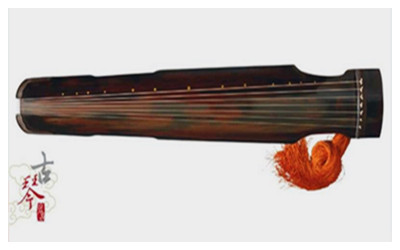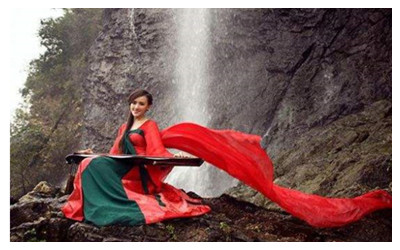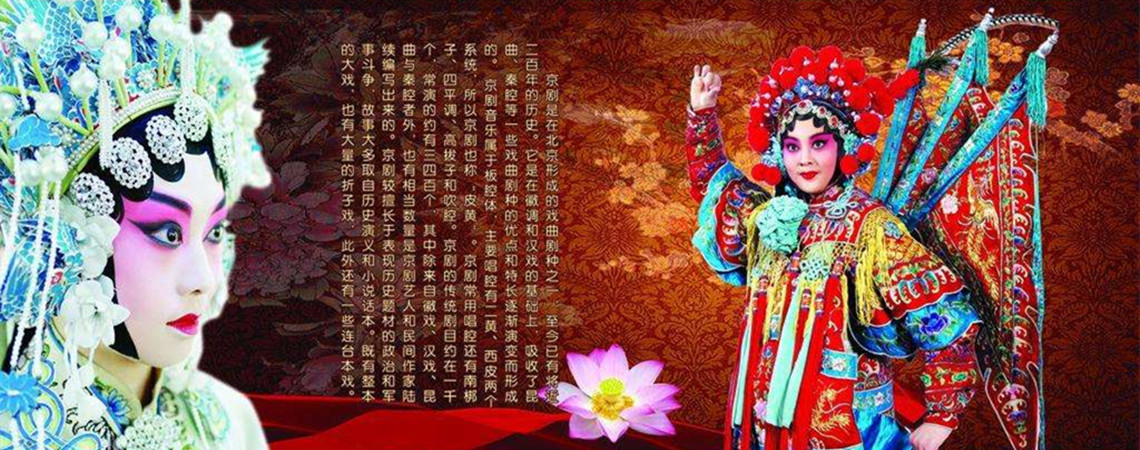- Home
- Travel In China > China Culture > Chinese Traditional Arts >
Guqin (古琴)
Guqin(古琴, literal translated to be The Ancient Stringed Instrument in Zither Family), also called Yaoqin (瑶琴, Precious Jade Zither), Yuqin(玉琴 Jade Zither) and Qi
Xianqin(七弦琴, Seven-String Zither), is one of the oldest plucking musical instruments in China.
History of Guqin

Guqin (古琴) is a traditional plucked strings instrument with a history more than 3,000 years, which has been listed as “Masterpieces of the Oral and Intangible Heritage of Mankind”. Usually the body of Guqin is elongated and hollow in the center. It is 120-125 centimeters long and has seven strings. The sound of Guqin is softer and the timbre is low and a little bit oppressive.
The oldest historical record of guqin is connected with Emperor Shun(舜) who sung Nanfengzhishi(南风之诗) in guqin. And Emperor Shun was the first famous master of guqin in primitive era of China, though guqin was not created by him but was said to be created by Emperor Fuxi(伏羲), who was also the creator of Yin-yang theory. Guqin as an old and mysterious musical instrument shares roughly a long time with Chinese history. In accordance with the written record, it has more than 4, 000 years of history. In the period of Confucius, Guqin had been the quite popular musical instrument. In terms of the Records of the Grand Historian, the appearance time of Guqin is approximately earlier than the period of Emperors Yao and Shun(尧舜时期). In the early 20th century, to distinguish this musical instrument from the western musical instruments, Gu, an adjective meaning the ancient, was added in front of Qin, and since then, Guqin as an old but also refreshing term in music officially appeared. Today, we still can hear the ancient melody of Guqin from elite’s studies and performance stages.
In the long history of ancient China, the study of Four Talents used to be the unavoidable access to the elegance and well cultivation in the mind of the traditional literati and scholars. And Qin is ranked the first among four talents(琴棋书画, Qin Chess, Calligraphy and Painting). Due to the musical characters of Quqin: Clearance, Harmony, Lightness and Elegance, it is the best representation of the internality and personality of the elites or scholars. The ancient people believed that Qin meant Affection, and also meant restraint or limitation(琴者,情也;琴者,禁也).
In 2003, Guqin was listed into the List of Masterpieces of UNESCO Oral and Intangible Heritage.
Music of Guqin

Guqin as the most famous musicial instrument in the world is closely connected with China culture and the cultivation of personal characters as well as the personality. Playing guqin is the must of ancient elite’s life development, the famous masters of Guqin included: Fuxi, Emperor Shun, Confucius, Sima
Xiangru, Yu Boya and Zhong Ziqi, King
Zhuangwang of Chu State, King Huan of Qi State, Cai Yong, Su Shi and so on.
There are also a lot of famous masterpieces of guqin like Gaoshan Liushui(高山流水),
Hangong Qiuyue(汉宫秋月) and Feng Qiu Huang(凤求凰), the famous ancient guqin include: Haozhong(号钟), Raoliang(绕梁), Lvqi(绿绮), Jiaowei(焦尾), Chunlei(春雷), Jiuxiao Huanpei(九霄环佩) and Taigu Yiyin(太古遗音).
There are more than 3360 pieces of Guqin music in the world, more than 130 pieces of Guqin scores, and 300 pieces of Guqin songs. On November 7, 2003, the UNESCO World Heritage Committee announced that Chinese Guqin was selected as the World Cultural Heritage. And it was inscribed in
China's Intangible Cultural Heritage List in 2006.

 Guqin (古琴) is a traditional plucked strings instrument with a history more than 3,000 years, which has been listed as “Masterpieces of the Oral and Intangible Heritage of Mankind”. Usually the body of Guqin is elongated and hollow in the center. It is 120-125 centimeters long and has seven strings. The sound of Guqin is softer and the timbre is low and a little bit oppressive.
Guqin (古琴) is a traditional plucked strings instrument with a history more than 3,000 years, which has been listed as “Masterpieces of the Oral and Intangible Heritage of Mankind”. Usually the body of Guqin is elongated and hollow in the center. It is 120-125 centimeters long and has seven strings. The sound of Guqin is softer and the timbre is low and a little bit oppressive. Guqin as the most famous musicial instrument in the world is closely connected with China culture and the cultivation of personal characters as well as the personality. Playing guqin is the must of ancient elite’s life development, the famous masters of Guqin included: Fuxi, Emperor Shun, Confucius, Sima Xiangru, Yu Boya and Zhong Ziqi, King Zhuangwang of Chu State, King Huan of Qi State, Cai Yong, Su Shi and so on.
Guqin as the most famous musicial instrument in the world is closely connected with China culture and the cultivation of personal characters as well as the personality. Playing guqin is the must of ancient elite’s life development, the famous masters of Guqin included: Fuxi, Emperor Shun, Confucius, Sima Xiangru, Yu Boya and Zhong Ziqi, King Zhuangwang of Chu State, King Huan of Qi State, Cai Yong, Su Shi and so on. Ask Questions ?
Ask Questions ?